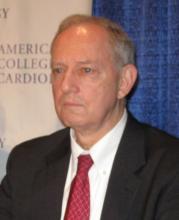NEW ORLEANS – Myocardial viability failed to predict a significant survival benefit from coronary bypass surgery in patients with coronary artery disease and left ventricular dysfunction in the STICH Viability substudy.
The data are surprising and call into question the long-standing practice of assessing myocardial viability as a means to predict clinical benefit from coronary bypass surgery.
The substudy included 610 of the 1,212 patients in the Surgical Treatment for Ischemic Heart Failure (STICH) trial who underwent baseline myocardial viability testing using SPECT or dobutamine echocardiography, or both, and were randomly assigned to aggressive medical therapy with or without coronary artery bypass surgery (CABG).
At a median follow-up of 5 years, 51% of patients without viable myocardium and 37% with viable myocardium died. The presence of viable myocardium significantly reduced the risk of all-cause mortality by 36%, but the survival advantage lost statistical significance in a multivariable analysis that included other prognostic variables, Dr. Robert Bonow reported at the annual meeting of the American College of Cardiology.
The secondary outcome of cardiovascular mortality was also significantly lower in patients with myocardial viability compared with those without myocardial viability, at 29% and 43%, respectively, but once again, the association lost significance in multivariable analysis.
Notably, the secondary composite end point of death plus cardiovascular hospitalization, which is commonly used in heart failure trials, retained significance in multivariable analysis in favor of patients with myocardial viability, occurring in 63% of patients with viable myocardium and 82% of those without.
There was no significant interaction, however, between myocardial viability status and medical versus surgical treatment with respect to mortality, whether assessed according to treatment assigned or to the treatment actually received, said Dr. Bonow, professor of cardiology at Northwestern University in Chicago. Five-year all-cause mortality rates among the 114 patients without myocardial viability were 56% with medical therapy and 42% with CABG. Among the 487 patients with myocardial viability the rates were 35% vs. 31%, respectively.
"The lack of interaction between myocardial viability and benefit from CABG in this study indicates that assessment of myocardial viability, independent of other relevant variables, should not be the deciding factor in selecting the best therapy for patients with ischemic left ventricular function," he said.
Discussant Bernard Gersh, professor of medicine at Mayo Clinic in Rochester, Minn., asked what clinicians should analyze to determine which of their patients with heart failure and coronary disease to send to surgery, particularly in light of the benefits observed with CABG in the primary STICH analysis. Those data showed a 5% reduction in all-cause mortality at 6 years with the addition of CABG to medical therapy.
Dr. Bonow replied, "I think viability may be something you look at in some patients, but the point would be that there are other clinical variables, perhaps coronary anatomy, that one would bring into play."
Dr. Steven Bollings, with the Cardiovascular Center at the University of Michigan in Ann Arbor, said the primary STICH results provide a clear answer that patients with heart failure and left ventricular dysfunction benefit from coronary bypass surgery, but that the viability substudy raises a number of questions. He said that myocardial "may not be the No. 1 criterion by which we send patients to the operating room" and that other variables such as whether the patient has clear distal targets or is robust may be more important.
Dr. Gregg W. Stone of Columbia University, New York, said, "While I admit this is the clearly the best and most important viability study ever done, I don’t know that it definitively answers the question for us that viability doesn’t matter."
He pointed out that the viability data were based on only half of the STICH participants, the subsets were unbalanced with 80% of patients having viable myocardium and that some would say it’s not appropriate to look for interaction testing off of a negative end point.
"What I take away from this is that if there’s viability, I really want to be sure to revascularize," said Dr. Ted E. Feldman of NorthShore University HealthSystem in Evanston, Ill. "But prior to seeing these results, I was inclined to say if there wasn’t viability, not to vascularize. And the results of the trial challenge that historic bias," he added.
STICH Viability was supported by grants from the National Heart, Lung, and Blood Institute and Abbott Laboratories. Dr. Bonow had no relevant disclosures.


